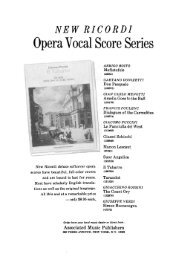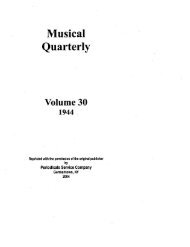Jimmie Rodgers and the Semiosis of the Hillbilly ... - Musical Quarterly
Jimmie Rodgers and the Semiosis of the Hillbilly ... - Musical Quarterly
Jimmie Rodgers and the Semiosis of the Hillbilly ... - Musical Quarterly
You also want an ePaper? Increase the reach of your titles
YUMPU automatically turns print PDFs into web optimized ePapers that Google loves.
<strong>Jimmie</strong> <strong>Rodgers</strong> <strong>and</strong> <strong>the</strong> <strong>Semiosis</strong> <strong>of</strong> <strong>the</strong> <strong>Hillbilly</strong> Yodel Page 5 <strong>of</strong> 39<br />
connection is impossible to establish with any certainty. 20 Tosches<br />
appears particularly eager to assert <strong>the</strong> influence <strong>of</strong> Miller on <strong>Rodgers</strong>.<br />
Yet as interesting as <strong>the</strong>se <strong>the</strong>ories may be, ultimately <strong>the</strong>y are not<br />
necessary to explain where <strong>Rodgers</strong> got his yodel. Quite obviously <strong>the</strong>re<br />
was no single source <strong>of</strong> influence upon <strong>Jimmie</strong> <strong>Rodgers</strong>, for <strong>the</strong> simple<br />
reason that yodeling surrounded him on all sides: yodeling was everywhere,<br />
in many styles <strong>and</strong> genres. To imagine it was Swiss troupes, or<br />
Goebel Reeves, or Emmett Miller who influenced him is too specific,<br />
<strong>and</strong> unnecessarily so. Black-inflected Tin Pan Alley yodel songs such as<br />
“Alpine Blues,” “When They Yodel Ragtime Songs in Tennessee,” or<br />
“The Ragtime Yodling [sic] Man”—this one with <strong>the</strong> yodel break over<br />
an eight-bar blues chord progression—demonstrate that ragtimeblues-influenced<br />
yodeling was widely current long before <strong>Rodgers</strong>,<br />
Reeves, <strong>and</strong> Miller began recording. 21 Moreover, <strong>the</strong> variety <strong>of</strong> <strong>the</strong><br />
yodeled vocal figures <strong>Rodgers</strong> used reveals his eclectic interests as well as<br />
his innovations. Clearly, he was influenced by many traditions <strong>and</strong><br />
styles, not by just one, <strong>and</strong> certainly not by only one performer such as<br />
Emmett Miller, whose yodeling <strong>Rodgers</strong>’s resembles only occasionally.<br />
<strong>Rodgers</strong>’s yodel figures include not only melodic patterns that would<br />
have been familiar to a large section <strong>of</strong> his original audience, but also<br />
o<strong>the</strong>r vocal devices that were drawn from o<strong>the</strong>r popular singers but<br />
which apparently had never been coupled with yodeling. Yet <strong>the</strong>se have<br />
hi<strong>the</strong>rto received scant, if any, attention. So while questions <strong>of</strong> priority<br />
arise here somewhat incidentally, <strong>the</strong> present study is not concerned so<br />
much with who did what first or who influenced whom, but ra<strong>the</strong>r with<br />
<strong>the</strong> evolution in <strong>Rodgers</strong>’s recordings <strong>of</strong> preexisting patterns. In <strong>the</strong><br />
process, such issues as <strong>the</strong> influence <strong>of</strong> “black falsetto,” discussed later,<br />
are problematized. The focus <strong>of</strong> this study is on <strong>the</strong> connotative uses <strong>of</strong><br />
yodel melodies <strong>and</strong> <strong>the</strong> codification <strong>of</strong> certain patterns in this body <strong>of</strong><br />
work, thus <strong>the</strong> term “semiosis” in my title.<br />
The Nature <strong>and</strong> Significance <strong>of</strong> Yodeling in <strong>Jimmie</strong><br />
<strong>Rodgers</strong>’s Songs<br />
Viewing <strong>the</strong> hillbilly-music phenomenon as a commercial endeavor—in<br />
o<strong>the</strong>r words, not from <strong>the</strong> narrow point <strong>of</strong> view <strong>of</strong> <strong>the</strong> folklorists—<br />
Richard Peterson in Creating Country, Fabricating Au<strong>the</strong>nticity gives a perceptive<br />
account <strong>of</strong> <strong>the</strong> nature <strong>of</strong> <strong>Rodgers</strong>’s material <strong>and</strong> especially <strong>the</strong><br />
role <strong>of</strong> his A&R (Artist & Repertoire) man, Ralph Peer. 22 Peer actually<br />
had very little or no interest at all in <strong>the</strong> music made by <strong>the</strong> hillbilly performers<br />
he recorded. It was purely a commercial concern to him. There<br />
was a market for this music, he knew, <strong>and</strong> sizable pr<strong>of</strong>its to be made,<br />
Downloaded from<br />
http://mq.oxfordjournals.org/ by guest on July 15, 2013







